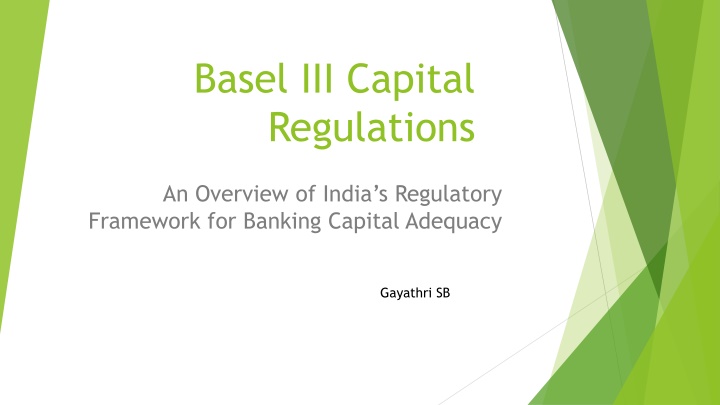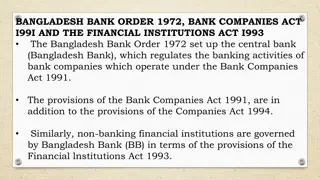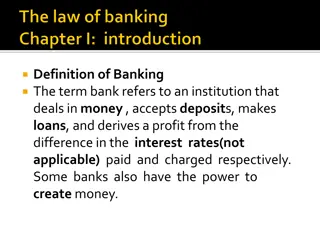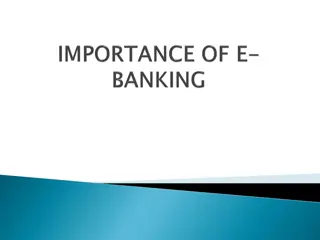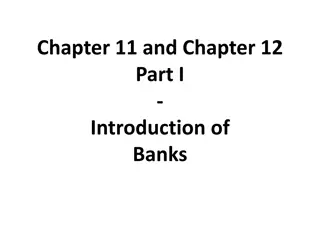Overview of India's Regulatory Framework for Banking Capital Adequacy
Basel III Capital Regulations play a crucial role in enhancing banks' ability to absorb shocks, managing credit, market, and operational risks, and ensuring stability in the financial system. Learn about the key objectives, features of Basel I, II, III, risk coverage under Basel III, and mitigation strategies for liquidity and market risks.
Download Presentation

Please find below an Image/Link to download the presentation.
The content on the website is provided AS IS for your information and personal use only. It may not be sold, licensed, or shared on other websites without obtaining consent from the author.If you encounter any issues during the download, it is possible that the publisher has removed the file from their server.
You are allowed to download the files provided on this website for personal or commercial use, subject to the condition that they are used lawfully. All files are the property of their respective owners.
The content on the website is provided AS IS for your information and personal use only. It may not be sold, licensed, or shared on other websites without obtaining consent from the author.
E N D
Presentation Transcript
Basel III Capital Regulations An Overview of India s Regulatory Framework for Banking Capital Adequacy Gayathri SB
Key objectives of Basel III Enhance bank s ability to absorb shocks Credit Risk Lending to different borrowers Risk of NPA Market Risk Exposure to Financial Markets Operational Risk Arising from Internal processes and system failures Stability of the Financial system Ensure Indian Banks meet international capital standards
Bank for International Settlements Basel - Switzerland Central bank for Central banks
Feature Basel I Basel II Basel III Year 1988 2004 2010-2018 Focus Credit Risk Credit, market and Operational risk Credit/ Liquidity/ Market/ Operational/ systemic/ Forex/ Credit concentration 10.5% of RWA (With buffers) Capital Requirement 8% of Risk Weighted Assets (RWA) Varied by Risk sensitivity Key feature Minimum capital requirement 3 pillars 1. Minimum capital 2. Supervisory review 3. Market Discipline 1. Strengthened capital requirements 2. Leverage and liquidity 3. Risk Sensitivity 4. Focus on systemic risk (Banks are Too big to fail institutions) ?? Limitations Does not address any risk other than credit risk 1. Implementation complexity for smaller banks 2. Relied heavily on external credit rating (For risk weights) 3. Financial crisis 2008
Risk Coverage under Basel III Credit Risk 2008 Global Financial Crisis - subprime mortgage lending Lending to borrowers with low credit rating at a higher interest rate Surge in housing demand and speculative investment led to skyrocketing home prices Assuming increase in home values, subprime borrowers took risky loans and failed in repayment Home prices fell Mitigation - Basel III introduced higher capital requirements for credit risk, especially for risk-weighted assets (RWA). The implementation of better stress testing also helps banks evaluate potential credit shocks.
Liquidity risk The northern rock crisis 2007 Heavy reliance on short-term borrowing to finance long-term loans. Aggressive lending fueled rapid expansion but concealed vulnerabilities. Mitigation - Basel III introduced the Liquidity Coverage Ratio (LCR) and Net Stable Funding Ratio (NSFR) to ensure banks hold sufficient high-quality liquid assets (HQLAs) to cover short-term cash outflows and maintain stable funding profiles Market Risk 2008 Financial Crisis Over-inflated housing prices and reckless lending practices in the US led to a housing market crash Mitigation - Basel III introduced more sophisticated tools for measuring market risk, such as the Internal Models Approach and more stringent capital buffers
Credit Concentration Risk Banks heavily exposed to the real estate sector during the subprime mortgage crisis in 2007-2008 saw significant losses when the housing market collapsed Mitigation - Basel III requires banks to diversify their portfolios and to hold more capital against concentrated exposures, both at the borrower and sector levels. It also introduced more stringent **large exposure limits** to prevent over-concentration.
Pillars of Basel Framework Pillar 1: Minimum Capital Requirements covers risk types and capital adequacy. Pillar 2: Supervisory Review addresses each bank's risk profile, internal processes. Pillar 3: Market Discipline focuses on transparency and public disclosure.
Scope of applicability of capital Adequacy framework Banks shall comply at both levels Consolidated Based on capital strength after consolidating subsidiaries/ JV/ Associates Except those in Insurance or non-finance activities 1. Standalone 2. (Includes Overseas branch operations in both cases)
Elements of Regulatory Capital Tier 1 Capital (Going-concern capital) Absorb losses continuing operations Common Equity Tier I 1. Paid-up Equity capital Share Premium Statutory Reserves Capital Reserve Other disclosed Free Reserves Balance in P/L at the end of previous financial year Eligible profit of current year = Net profit upto the quarter (0.25*Average dividend of last 3 years*Quarter of the year)
Additional Capital Perpetual Non-cumulative preference shares Premium on PNCPS Tier II capital (Gone-concern capital) Absorb losses during winding-up 1. General provision and loss reserve General provision on standard assets Excess Provision on sale of NPA Investment reserve Debt capital instruments Perpetual cumulative Preference shares Redeemable non-cumulative PS Redeemable Cumulative PS Premium on above
Adjustments/ Deductions Goodwill and other intangible assets net of DTL if any Operating losses in current year/ bought forward and associated DTA Cash flow hedge reserve Gain on sale related to securitisation Defined Benefit pension fund asset Investment in own shares Investment in Banking/ Insurance/ Financial instituition
Criteria for classification as common shares Annexure I Voting shares or at least identical to voting shares in all aspects except absence of voting rights Subordinated claim (ranks lower than other claims) Unlimited or variable claim on liquidation Claim on residual assets proportionate to paid up capital Perpetual principal Not repaid except on liquidation (Other than Buy-back) Distributions made on distributable profits/ Non-obligatory distributions Classified as Equity capital on insolvency Classified as Equity capital by Accounting standards Neither secured nor guaranteed
Regulatory Capital Minimum Common Equity Tier 1 ratio Capital Conservation Buffer Additional Tier 1 capital Tier 2 capital Minimum Total Capital Ratio Minimum total capital + CCB As a % of Risk Weighted Assets 5.5 2.5 Capital Structure Requirements 1.5 2.0 9.0 11.5 Composition of Capital Tier 1 Capital: Includes CET1 and Additional Tier 1 (AT1). CET1 Elements: Common shares, statutory reserves, profit & loss balance. Tier 2 Capital: Composed of items like loan-loss reserves, certain debt instruments, and revaluation reserves
Common Equity Common Equity Tier I capital / Tier I capital ratio = Risk Weighted Average (RWA) Tier I capital ratio = Tier I capital / RWA assets Capital to Risk Eligible total capital / RWA Weighted Assets = assets
Capital Charge for Credit Risk-Standardised Approach Asset Category Examples - Cash - Government bonds (AAA rated) - Claims on central banks - Foreign Sovereigns - Interbank loans - Claims on other financial institutions - Loans to corporates - Bonds issued by corporations - Consumer loans - Credit card receivables - Small business loans - Equity investments in subsidiaries - Publicly traded equities Risk Weight 0% for highly rated sovereigns Higher for lower ratings (S&P/ Moody s) Cash and Sovereign Exposures Bank Exposures 20% to 150%, based on counterparty credit rating Corporate Exposures 100% for unrated corporates Varies by rating Retail Exposures 75%, reflecting lower default correlation Equity Exposures 100% to 400%, depending on type of equity
Capital Charge for Credit Risk Asset Category Examples Risk Weight - Residential mortgages - Commercial property loans 35% for residential mortgages 100%+ for commercial loans 20% to 1,250%, based on tranche seniority and rating Real Estate Exposures Securitization Exposures - Mortgage-Backed Securities (MBS) - Asset-Backed Securities (ABS) - Loans overdue for more than 90 days - Loan commitments - Derivatives - Guarantees Non-Performing Assets (NPAs) Off-Balance Sheet Exposures 150% or higher Adjusted using Credit Conversion Factors (CCFs)
Capital charge for Operational Risk The Basic Indicator Approach 15% of Average Gross income wherever positive for the previous 3 years Where gross income is Net interest Income + net non-interest Income Gross of provisions and write-offs Gross of operational expense Exclude reversal during the year of above Exclude income from disposal of movable and immovable property/ security held to maturity Exclude income from legal settlements/ extraordinary/ irregular/ insurance activities
Capital charge for Market Risk The standardised duration approach Risk weights and factors based on size and complexity of bank 1. Interest Rate Risk 2. Equity Risk 3. Forex risk 4. Commodity Risk
Capital Conservation and Countercyclical Buffers Capital Conservation Buffer (CCB): A buffer to absorb losses in financial stress, totaling 2.5% of RWA. Maintain Common Equity Tier I to be 2.5% above 9% Should not distribute profits when level falls below this But can operate. Countercyclical Capital Buffer: To mitigate risks by adding capital during growth and withdrawing during requirement/ losses. Ranges from 0-2.5% of RWA depending on assessment by regulator
Domestic Systemically Important Banks The too big to fail banks Additional capital requirement Tier 1 0.2% to 0.8% of RWA depending on systemic Importance
Leverage Ratio Requirements Purpose: To restrict banks from excessive leveraging. Ratio Calculation: Based on Tier 1 Capital and total consolidated assets. Impact: Serves as a backstop to risk-based capital ratios. The leverage ratio shall not fall below 4.5% Liquidity Coverage Ratio(100%): Ensure banks have sufficient high quality liquid assets to withstand a 30-day period of liquidity stress LCR = High-quality Liquid Assets/Net cash outflow over 30 days Net Stable Funding Ratio - minimum NSFR is set at 100% to promote long-term financial stability. Stable funding for 1 year
Supervisory Review and Evaluation Process Internal Capital Adequacy Assessment Process (ICAAP) - Banks to assess their own capital needs based on their risk profiles Ensure they hold adequate capital to cover these risks Stress Testing - understand potential vulnerabilities and take preventive measures RBI to conduct a supervisory review of banks internal risk management practices and their capital adequacy in relation to the risks Address risks beyond Pillar I Credit concentration risk Reputational Risk Strategic risk Model risk Risk of Securitisation Poor Portfolio risk mgmt. Lack of attention to changes in Economic circumstances
The 4 principles Assess Capital adequacy in relation to risk profile and maintain 1. Supervisors to review and evaluate capital adequacy 2. Supervisors to require banks to hold capital more than minimum level 3. Prevent capital from falling/ require rapid remedial action 4. Ensure: Higher the risk, higher the capital Capital can be reduced only if risk mitigated / reduced
Disclosure Requirements Market Discipline To improve transparency and the quality of information provided by banks to regulators and the public Mandated banks disclose key information on their capital adequacy, risk exposures, liquidity, and risk management practices. Quarterly disclosures on their CET1, Tier 1, and Total Capital ratios, LCR, and NSFR Other disclosures 1. Securitisation exposure in trading book and valuation 2. Sponsorship of off-balance sheet vehicle
Limitations of Basel III Phased roll out (2013 2028), delayed its full impact. Complex for small banks (require significant resources for risk assessment, reporting, and technology upgrades) Focuses on larger banks leaving loopholes for small banks and NBFC non-bank entities, such as hedge funds and private equity, are not adequately mitigated. LCR of 30 days not adequate for prolonged crisis Requires sophisticated modeling and subjective judgment for calculating RWA Higher capital requirements may lead to reduced lending, potentially stifling economic growth Cost of compliance passed on to the customer Manipulation of RWA relies on timely and accurate data, which is challenging during real-time economic stress 1. 2. 3. 4. 5. 6. 7. 8. 9. 10.
Menti.com 1324 6925
